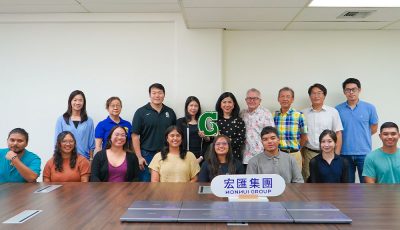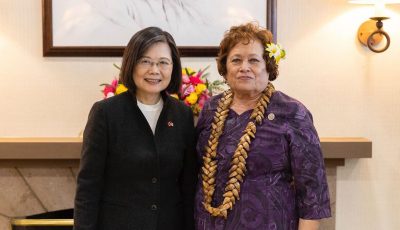Taiwan
Diversity is a word much bandied about these days in various contexts, mostly social. For our purposes today we want to look at how economic diversity impacts the fragile economy of the CNMI. The answer is…not enough. A diverse economy, with income money coming in from a variety of sources, is less vulnerable to hiccups in the global economy that we have no control over. A diverse economy is able to withstand a sizable economic hit and limp away, still operating where a less diverse or single-source economy often collapses or falls back so far that it takes many years to get back into the game again.
For the CNMI, still sitting here after 15 years of halfhearted effort to expand our economy beyond tourism, we are still a single-source economy—tourism. It is a dangerous industry to rely on because it is so volatile and so vulnerable to outside influences. Nevertheless, that is what we have and all we have. Begging Uncle Sam for grants and emergency assistance has netted us about $100 million a year average over the decades in non-typhoon years but that is not an industry; it is a part-time job for a high-schooler looking for gas money for his jalopy.
So here we are with a single-source economy, what can we do to maximize its potential? We can look for multiple sources of income within that single source. In our case that means increasing the number of regionally viable countries to bring our tourists and their dollars from. Candidates need to have a few important characteristics to be useful to us: proximity, air service, political stability, and an outbound tourist market big enough to be meaningful are the most important of these. Tourists, like you and me, like to travel to places that are relatively close. Travel time up to three hours is considered “short haul” while up to five or six hours is medium. “Long haul” trips of six hours or more are hard on the body, hard on the wallet and hard on that most important quality of vacationing—time—plus they induce that favorite feeling, jet lag, which eats up even more valuable visitor time.
Enter Taiwan as a candidate. With 23 million mostly prosperous residents, the 23rd largest economy in the whole world, a travel time in the upper short haul range and a seasoned traveling public, Taiwan fits our needs perfectly. Back in the early ’90s Taiwan provided a fairly consistent 20,000-plus visitors to the CNMI annually. Direct flights were the key then as they would be now to bringing in meaningful numbers of high spending Taiwanese tourists. Having a mature traveling public is both good and bad for us in the CNMI islands of Saipan, Tinian, and Rota. It means they are savvy and knowledgeable about destinations and their relative value as vacation spots. That means they are less tolerant about substandard facilities, infrastructure, or accommodations. It means that, like the Japanese, their more discerning tastes require us to step up our game and make our destination look, feel, and act the part of a welcoming, interesting and well equipped place to visit. We need improvement.
Several years ago, acting on that set of facts, MVA opened an office in Taipei, Taiwan’s capital city, with a small but professionally strong staff of experienced promotors. The idea was to generate enough interest in our destination to induce an airline to fly here direct. Sadly, to date, although we have been led all the way to the altar a number of times, no airline has yet introduced a flight from Taiwan to the CNMI. Without it, there will be no meaningful incoming arrival numbers. Those Taiwanese that want to come here (a few hundred per month currently) have to travel through Hong Kong (now politically unstable) or Japan, Korea, the Philippines, or occasionally Guam.
The question is, do we keep whipping that horse, knowing how badly we need the visitor arrivals from a different country or do we give up? I say keep on keeping on until we get those flights. Look at your map and you’ll see why. How many countries do you see that fit the needed parameters for a source country as mentioned above? Japan, Korea, China, Hong Kong, Far East Russia and, maaaaybe if you stretch it, Australia. Unless there are regional flights to OZ beyond Cannes, you can rule that out. It is another five or six hours south to Sydney and the other population centers. Taiwan is it. East Russia is the only other opportunity and MVA had until recently a promotional office there. That office actually generated a direct flight, which was on track to bring in 20,000 or so annual visitors when the politics and economics of Russia crashed the tourism industry, which is still trying to come back. Maybe later for Russia. As I say, keep on keeping on until we see those China Air or EVA Air flights from Taiwan landing on Saipan.
Boating
Boating is an important part of our image as a visitor destination. A picture of Managaha or the lagoon is seldom seen without a boat, which brings to the potential visitor’s mind a way for them to have a fun a relaxing day on Saipan. Seafaring tradition is a key part of our island’s heritage and to the extent that those commercial and historical experiences are made available to our visitors, our reputation and image is built stronger.
It is nice to see that a new boating organization has been formed here on Saipan. It calls for inclusionary access to commercial, pleasure and sport boating communities but I notice most all the members fall into the latter two categories and most of their boats are docked at the Smiling Cove. Let’s hope they reach out successfully to the commercial boaters on whose businesses our tourism hopes lie as those operators are under extreme pressure from the DLNR as they and F&W “close” but charge arms and legs to continue using the broken Outer Cove Marina as a base for their operations. Many of those on the board of the new organization could help bring some pressure to bear if they were so inclined. Please?



























